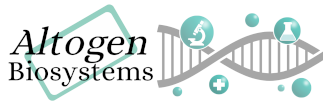Shop Products
AltoFect Transfection Reagent for Primary Cells and Hard-to-transfect Cell Lines
Altogen Biosystems developed AltoFect™ Transfection Reagent – a new generation transfection reagent optimized for high transfection efficiency of primary cells and difficult-to-transfect cell lines. It has been successfully tested to deliver all types of nucleic acids (plasmid DNA constructs, si/miRNA, shRNA, dsRNA, mRNA, etc), small proteins, and negatively charged small molecules. Cancer cell lines and primary cell types, a suspension or adherent cells, will have a different property and composition of its cellular membrane (charge, receptors, orientation, thickness, ration of lipid/cholesterol composition, etc). The AltoFect™ reagent takes advantage of the physical property of cellular membrane lipid-based structure and is capable to deliver functional biomolecules into target cells. This transfection reagent can be used to create inducible stable cell lines that can be particularly useful for cells that are refractory to transfection. Research applications include gene expression and gene silencing studies, library screening (e.g. RNAi genome-wide assays), recombinant protein production and analysis.
Transfection is a common life science laboratory technique for deliberate introduction of nucleic acid – DNA or RNA into a cell. Transfection methods were first developed by utilizing calcium phosphate and DEAE-dextran. These chemical based methods were revolutionary at the time as they did not have to rely on viral based methods to introduce genetic material into cells. Unfortunately, only very few cancer cell lines are easily transfectable in vitro, absolute majority of cancer cell lines require reagent and experimental conditions optimization that often takes substantial amount of time (single transfection experiment require preparation of cell culture to be in exponential growth phase plus 3-4 days of transfection and follow up cell-based assay and/or RNA/DNA expression analysis).
The goal in any transfection experiment is high transfection efficiency (level of expression of the construct) with minimal cytotoxicity. Achieving minimal stress to cells and reproducibility across experiments is influenced by the protocol used, cell lines, and reagents. Also, the quality of nucleic acid has an influence on high transfection efficiency. A low passage number in cells allow cells to be more amenable to uptake the nucleic acid. There is no single method which can be reproduced across cell types and experiments with high transfection efficacy. .
In vitro transfection consists of either chemical or physical methods. Chemical transfection is common for transient transfection experiments for short term expression of the desired gene that last a few days. The workflow of a chemical transfection experiment usually includes plating cells at lower subconfluency, preparing the transfection reagent / DNA or RNA complex immediately before transfection, and then assessing construct expression 48-72 hours post-transfection. Cell culture medium is refreshed 24-48 hours after plating the cells. Lipofection is the transfection using liposomes, small synthetic molecules which can fuse with cell membranes and are able to release their contents. Cationic polymers are also commonly used for intracellular delivery of negatively charged nucleic acids, however optimization of the transfection protocol must be undertaken to ensure that the method is not toxic to the cells.
Physical transfection methods are effective for many cell types (especially suspension cells), however disruption of the cellular membrane typically results in high cell death and overall low cell viability. Physical methods include electroporation (applying electric pulse to create “electropores” within cellular membrane), microinjection and biolistic particle delivery. Microinjection is commonly used to introduce DNA and RNA into single cells such as embryonic stem cells. With the aid a micromanipulator and microscope, the DNA or RNA is directly inserted into the cytoplasm or nucleus. This is typically time consuming, but results in very high transfection efficiency. Biolistic particle delivery relies on microparticles carrying nucleic acid to introduce DNA or RNA into cells.
Reporter gene assays are used to study gene expression, signal transduction, cellular mechanisms and molecular pathways. The most common reporter systems to measure transfection efficiency include using a green fluorescent protein (GFP), Luciferase (Luc), and β-galactosidase (β-gal) assays. Cells are transfected with a GFP-encoding plasmid or luciferase expression plasmid and expression of reporter signal (GFP, RFP, YFP, Luciferase, etc) is measured 24-72 hours post-transfection.
AltoFect™ Transfection Reagent – a new generation transfection reagent for high transfection efficiency of primary cells and difficult-to-transfect cancer cell lines.





Sorry, comments are closed for this post.